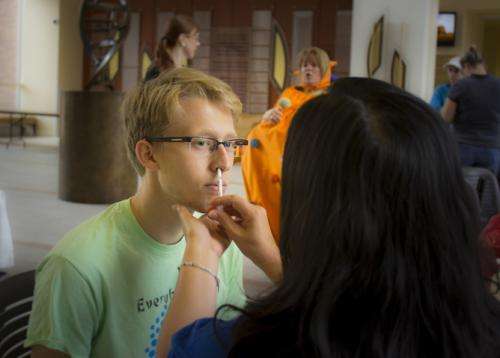Achieving community immunity against flu, one school at a time

Each fall flu can strike a community like a wildfire. Initially, cases are sporadic, but eventually they spread person to person. And like a wildfire, the aftermath can be severe: high economic losses, hundreds hospitalized and dozens dead.
Some people spread the flu more than others. For instance, children are flu super spreaders. They shed more virus than adults, and do so for a longer period of time. Now put these super spreaders together in one building all day long during flu season, and you can understand how schools act as virus exchange systems, ultimately spreading the flu beyond the classroom and into the whole community.
Need to protect a community from the flu? Go where the super spreaders are
Because of this reality, studies suggest that one of the most effective methods to protect a community from flu is by immunizing children. In fact, computer modeling studies suggest that immunizing 70% of schoolchildren could prevent outbreaks from occurring. These models are based on the concept of community immunity, also known as herd immunity.
Community immunity limits the spread of a contagious disease because a substantial proportion of the population is immune to the virus or bacteria. People are immune because they have been vaccinated or because they have been infected before, which confers immunity. Either way, it means that immune people can't spread the illness. This strategy helps protect vulnerable groups that could die from flu, including newborns who are too young to get immunized, people with severe health conditions (eg, cancer patients) and the elderly. Community immunity is the flame retardant for the flu wildfire.
Although the Centers for Disease Control and Prevention has recommended annual vaccination for kids for several years now, vaccination rates remain well below the threshold needed for community immunity. And unlike the measles or mumps, flu vaccines must be given every year because the virus changes.
Though parents are concerned about flu, many can't afford to miss school or work to get their child protected every year. It's not always easy to find time to go to a doctor's appointment or wait in line at a clinic or pharmacy. School-Located Influenza Vaccination programs eliminate this barrier by providing the vaccine at school.
School-located vaccination programs aren't new

The first nationwide school-located vaccination program began in Japan after the devastating 1957 Asian influenza epidemic. During the ten year program, one life was saved for every 420 children immunized with the flu shot. Since then, these programs have been implemented in the United Kingdom, Hawaii and in dozens of counties in the United States: including Alachua County, Florida and Knox County, Tennessee.
Newer programs use the nasal spray vaccine, a more effective method of preventing the spread of the flu among healthy children.
Recent data from school-located programs have shown a reduction of illness and absenteeism – even among the unvaccinated children. One study found that immunizing about 50% of schoolchildren in Alachua county reduced their own risk for flu-related emergency room and urgent care visits by up to 79%. And the overall risk reduction in the community for flu – like emergency room and urgent care visits – was 65%.
Interestingly, high vaccination rates achieved by these programs suggest that parents, students, and community members believe in the concept of community immunity and a flu-free society.
The Alachua County program is run by a coalition of public and private schools, the county health department, the University of Florida and 30 other community civic groups and businesses from the Black Nurses Association to the United Way and even a local ice cream shop.
In the fall, teams of volunteers, staff and parents go to schools to promote the program and help run the vaccine clinics. At the end of each flu season, the community assembles to celebrate this flu-free initiative and to discuss the impact of their vaccination efforts.
School-located programs on a national level
Despite strong support for school-located programs among pediatricians, school and public-health officials, wider implementation and long-term sustainability has been dampened by financial obstacles, especially for health departments.
Programs targeting only students who are on Medicaid (insurance for children below the federal poverty level) or who have no insurance cannot be sustained without grants or donations. These programs incur two economic loses, one from low reimbursement rates from Medicaid, and a second from covering the cost for children who are uninsured.
Some programs have been sustainable by targeting privately insured children, and then using the surplus obtained from higher reimbursement amounts from private insurance companies to compensate for loss incurred from Medicaid and uninsured kids. More work is needed in order for these programs to be implemented at a larger scale to make the vaccine accessible to all children.
Though immunizing children through school-based programs may be a key strategy for flu control, it does not give adults a hall pass. Just like preventing wildfires, everyone must be vigilant and should get immunized to protect themselves and their loved ones from illness and death.
This story is published courtesy of The Conversation (under Creative Commons-Attribution/No derivatives).![]()
















